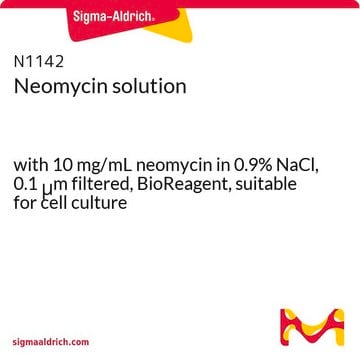SBR00022
Blasticidin S Ready Made Solution
10 mg/mL (20 mM HEPES), 0.22 μm filtered
About This Item
Polecane produkty
Poziom jakości
sterylność
0.22 μm filtered
Próba
≥98% (HPLC)
Postać
liquid
stężenie
10 mg/mL (20 mM HEPES)
kolor
colorless to faint yellow
spektrum działania antybiotyku
fungi
Tryb działania
protein synthesis | interferes
temp. przechowywania
−20°C
ciąg SMILES
CN(CCC(CC(=O)NC1C=CC(OC1C(=O)O)N2C=CC(=NC2=O)N)N)C(=N)N.Cl
InChI
1S/C17H26N8O5.ClH/c1-24(16(20)21)6-4-9(18)8-12(26)22-10-2-3-13(30-14(10)15(27)28)25-7-5-11(19)23-17(25)29;/h2-3,5,7,9-10,13-14H,4,6,8,18H2,1H3,(H3,20,21)(H,22,26)(H,27,28)(H2,19,23,29);1H
Klucz InChI
YQXYQOXRCNEATG-UHFFFAOYSA-N
Powiązane kategorie
Opis ogólny
In research, Blasticidin S has become a valuable tool, notably as a marker for strain manipulations. Recent applications involve the use of Blasticidin S as a selection agent for cells carrying plasmids conferring blasticidin resistance. The resistance is mediated by the blasticidin S deaminase genes (bsr from Bacillus cereus or BSD from Aspergillus terreus). These genes produce enzymes that catalyze the hydrolytic deamination of the cytosine moiety in blasticidin S, leading to the formation of a non-toxic deaminohydroxy derivative. This resistance mechanism is crucial in various studies involving genetic manipulations and selections in cell biology and biochemical research.
Zastosowanie
- studies to have fungicidal properties and prevents rice blast disease.
- used as a selection agent for transformed cells that contain the resistance genes bls, bsr, or bsd. Blasticidin S has been used to select HEK293-T cells with TLR-2 constructs and HEK-D5 cells.
- used to study protein synthesis at the level of peptide bond formation.
Działania biochem./fizjol.
Antimicrobial Spectrum: Active against mycobacteria, several Gram-positive and Gram-negative bacteria
Cechy i korzyści
- High-quality antibiotic suitable for multiple research applications
- Ideal for Cell Biology and Biochemical research
Inne uwagi
Hasło ostrzegawcze
Danger
Zwroty wskazujące rodzaj zagrożenia
Zwroty wskazujące środki ostrożności
Klasyfikacja zagrożeń
Acute Tox. 3 Oral
Kod klasy składowania
6.1D - Non-combustible acute toxic Cat.3 / toxic hazardous materials or hazardous materials causing chronic effects
Klasa zagrożenia wodnego (WGK)
WGK 1
Temperatura zapłonu (°F)
Not applicable
Temperatura zapłonu (°C)
Not applicable
Certyfikaty analizy (CoA)
Poszukaj Certyfikaty analizy (CoA), wpisując numer partii/serii produktów. Numery serii i partii można znaleźć na etykiecie produktu po słowach „seria” lub „partia”.
Masz już ten produkt?
Dokumenty związane z niedawno zakupionymi produktami zostały zamieszczone w Bibliotece dokumentów.
Klienci oglądali również te produkty
Nasz zespół naukowców ma doświadczenie we wszystkich obszarach badań, w tym w naukach przyrodniczych, materiałoznawstwie, syntezie chemicznej, chromatografii, analityce i wielu innych dziedzinach.
Skontaktuj się z zespołem ds. pomocy technicznej









